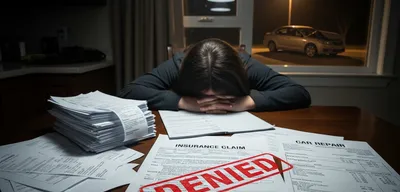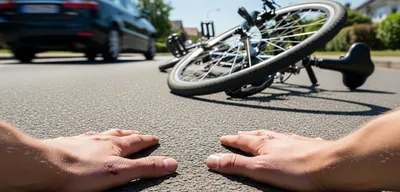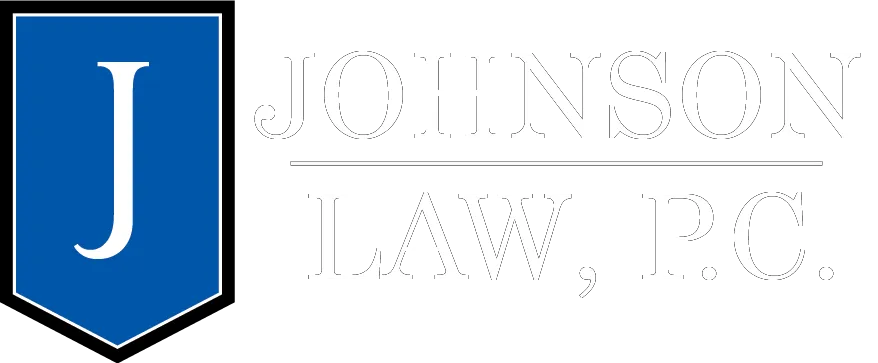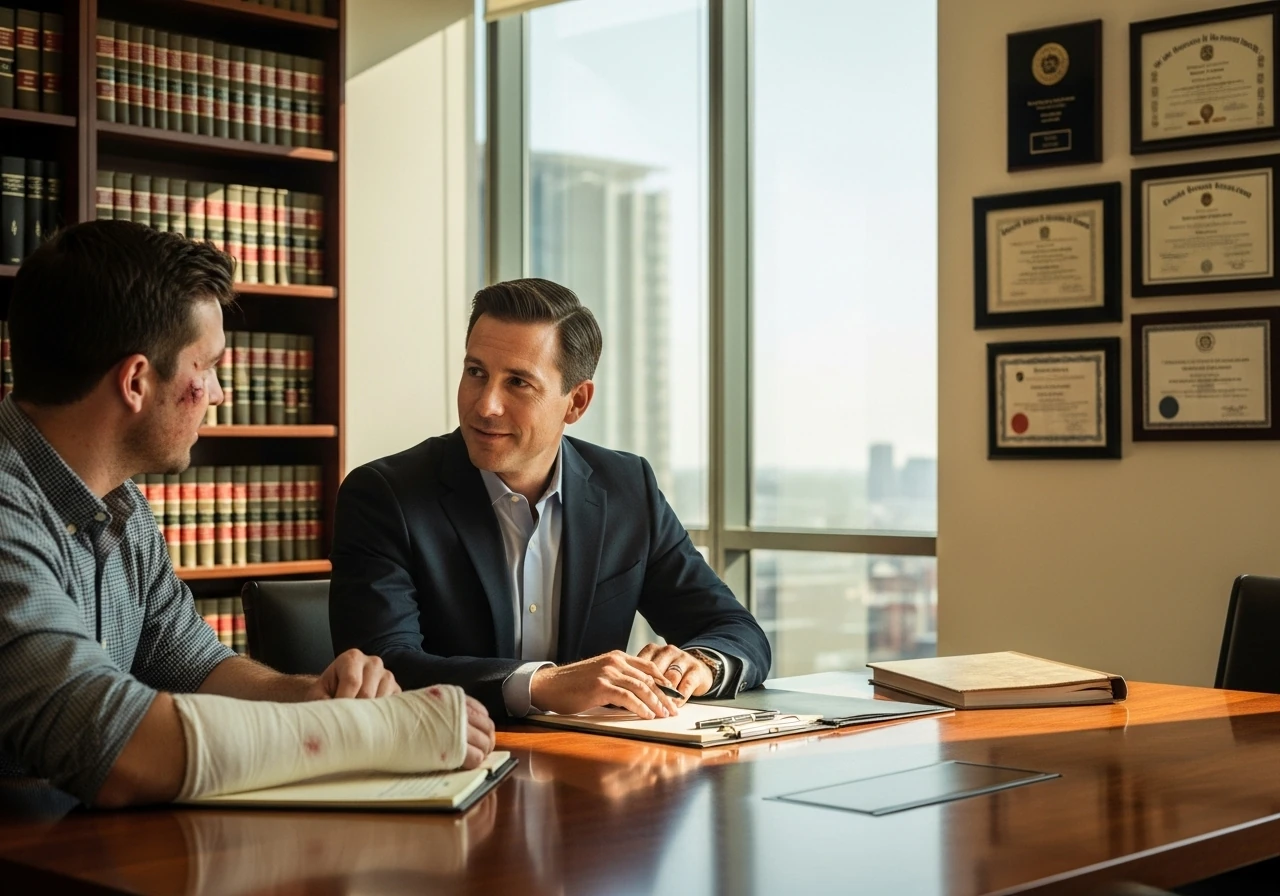Oregon Motorcycle Accident Legal Services
Oregon Motorcycle Accident Guide: Understanding Your Rights and Legal Options
When a motorcycle crash shatters your freedom, we fight for justice and fair compensation. Our experienced attorneys understand the specific challenges riders face and provide experienced guidance to protect your rights.

Start Here: Your Rights and Options
Riding Oregon's scenic highways offers a sense of freedom that few other experiences can match. But when that freedom is shattered by a motorcycle accident, the aftermath can be overwhelming, painful, and confusing. You're suddenly faced with serious injuries, mounting medical bills, and the daunting task of dealing with insurance companies who may not have your best interests at heart. To make matters worse, motorcyclists often face an unfair bias, with others quick to assume the rider was at fault.
This guide is here to cut through the confusion and level the playing field. It is designed to be your comprehensive resource for navigating the complex legal and insurance landscape after a motorcycle crash in Oregon. We will walk you through every critical stage of the process, from the essential actions to take at the scene to the intricacies of calculating the full value of your claim.
You will learn how to handle insurance adjusters, understand the specifics of Oregon's motorcycle laws, and see how fault is determined under the state's comparative negligence rules. Whether you're dealing with a minor collision or life-altering injuries, knowledge is your most powerful tool. Our goal is to provide the clear, straightforward information you need to protect your rights, make informed decisions, and focus on what matters most: your recovery.
The First Critical Steps After a Motorcycle Crash
In the chaotic moments immediately following a crash, your adrenaline is high, and it can be difficult to think clearly. However, the steps you take—or fail to take—can have a profound impact on both your physical recovery and your ability to secure fair compensation down the road. Acting deliberately and prioritizing correctly is key.
Your absolute first priority is your health. Before anything else, assess yourself for injuries and move to a safe location away from traffic if you are able. Call 911 immediately, even if you feel your injuries are minor. Adrenaline can easily mask serious conditions like internal bleeding or concussions that require urgent medical attention. Paramedics can provide immediate care, and their official report creates a vital record of your injuries from the moment of the accident.
If you are physically able to do so without further risk, your next step is to document the scene. Use your phone to take extensive photos and videos from multiple angles. Capture the final positions of the vehicles, damage to your motorcycle, skid marks, road conditions, and any relevant traffic signs. Exchange contact and insurance information with the other driver, but avoid discussing fault or apologizing. If there are any witnesses, get their names and phone numbers; their objective account can be invaluable.
Prioritizing Your Health and Safety
Nothing is more important than your physical well-being. In the immediate aftermath of a crash, your first and only job is to assess your condition and secure medical help. If you are conscious and able, move out of the path of traffic to a safer location, but only if you can do so without risking further injury. If you have any doubt about a potential back, neck, or head injury, it is far safer to remain where you are until emergency medical personnel arrive.
Always call 911 or have someone else do it for you. This step is non-negotiable, even for what seems like a minor incident. The adrenaline and shock from a collision are powerful and can effectively mask the symptoms of severe injuries. You might feel "shaken up but okay," while actually suffering from a concussion, internal bleeding, or significant soft tissue damage that won't become fully apparent for hours or even days.
Accepting evaluation and transport by paramedics is crucial. Their on-scene report creates the very first official record of your physical state, linking your injuries directly to the accident. Refusing medical attention at the scene is a common mistake that insurance companies later use to argue that your injuries weren't serious. Even if you are not taken to the hospital by ambulance, you must see a doctor for a full evaluation as soon as possible. This follow-up visit ensures that any delayed-onset injuries are properly diagnosed and documented, creating an essential medical record that will be fundamental to your personal injury claim.
Gathering Essential Evidence at the Scene
Once you have addressed your immediate medical needs and are in a safe location, your focus should shift to documenting the accident scene, provided you are physically able to do so. If you are too injured, ask a passenger or a helpful bystander to perform these steps for you. The evidence you collect in these first few minutes can become the bedrock of your claim, painting a clear picture of what happened before memories fade or the scene is cleared.
Your smartphone is your most powerful tool. Use it to take far more photos and videos than you think you'll need. Capture the entire scene from multiple angles—wide shots to show the context of the intersection or road, and close-ups detailing the specific points of impact on your motorcycle and the other vehicle(s). Be sure to photograph the other vehicle's license plate. Document any skid marks, debris on the pavement, road hazards like gravel or potholes, and relevant traffic signs or signals that might have influenced the crash.
Next, politely exchange essential information with the other driver. You need their full name, address, phone number, driver's license number, and insurance company name and policy number. The easiest way to capture this accurately is to take a clear photo of their driver's license and insurance card. While doing so, it is critical to stick to the facts. Do not apologize, admit any fault, or even say "I'm okay"—these statements can be used against you later. If there were any witnesses, get their names and contact information. An independent account of the accident can be incredibly persuasive for insurance adjusters and, if necessary, a jury.
Reporting the Accident: What You Need to Know
With this crucial information in hand, your next step is to ensure the accident is officially documented with the proper authorities. This formal reporting is not just a procedural formality; it creates the official record that your entire insurance claim will be built upon.
When law enforcement arrives at the scene, cooperate fully and provide a clear, factual statement of what occurred. Avoid guessing, speculating, or admitting any fault. The resulting police report is one of the most powerful pieces of evidence you can have. It is an impartial, third-party summary of the incident that includes the officer's observations, diagrams, vehicle and road conditions, and any citations issued. Insurance companies rely heavily on this report to make their initial liability decisions, so ensuring its creation and accuracy is vital.
Beyond the police report, Oregon has a specific legal requirement you must handle yourself. You are required to file an Oregon Traffic Accident and Insurance Report directly with the DMV within 72 hours of the crash if it results in any injury, a death, or property damage exceeding $2,500 to any single vehicle or property. This is your responsibility, even if the police filed their own report. Failing to submit this form on time can lead to the suspension of your driving privileges. Completing these official reports promptly and accurately transforms your on-scene evidence into a formal record, providing an indispensable foundation for protecting your rights and pursuing the compensation you deserve.
Why Motorcycle Accident Claims Are Different
Understanding the specific challenges motorcyclists face in personal injury claims
While the initial steps of documenting and reporting an accident are critical for any driver, they carry even greater weight for a motorcyclist. This is because a motorcycle accident claim is fundamentally different from a standard car crash case, presenting specific and often more difficult challenges. From the moment the crash occurs, you are not just dealing with an accident; you are battling against physics, stereotypes, and a legal framework that has specific rules for riders.
The Unfair Bias: Overcoming "Biker" Stereotypes
One of the most frustrating and damaging hurdles you will face is the persistent, unfair stereotype of the "reckless biker." In the eyes of many insurance adjusters, and potentially even a jury, the very act of riding a motorcycle implies a disregard for safety. They may conjure an image of a thrill-seeker weaving through traffic, rather than a responsible commuter who was simply in the wrong place at the wrong time.
This bias isn't just an annoyance; it has tangible consequences for your claim. An insurance adjuster may use this preconceived notion as leverage from their very first phone call. They might ask leading questions designed to paint you as aggressive or careless, hoping to get you to admit to some degree of fault. Their goal is to shift blame onto you, because under Oregon's comparative negligence law, every percentage of fault assigned to you reduces the amount of compensation they have to pay.
The Severity of Injuries and Long-Term Costs
Beyond the fight against unfair stereotypes lies the brutal physics of a motorcycle collision. Unlike car occupants shielded by a steel frame, airbags, and seatbelts, a rider's body absorbs the full force of the impact. This exposure means that even a low-speed crash can result in catastrophic harm. Injuries like traumatic brain injuries (TBIs), spinal cord damage, severe road rash requiring skin grafts, and multiple complex fractures are tragically common in these accidents.
The financial consequences of these severe injuries extend far beyond the initial hospital stay. A proper valuation of your claim must account for the full spectrum of long-term and future costs. This includes ongoing physical and occupational therapy, future surgeries, lifelong pain management, prescription medications, and necessary home modifications or assistive devices. Furthermore, a serious injury can permanently alter your ability to work in your chosen field, or at all, leading to a devastating loss of future income and earning capacity that must be professionally calculated.
Navigating Oregon's Specific Motorcycle Laws
Adding another layer of complexity are the specific traffic laws that apply only to motorcyclists in Oregon. A misunderstanding of these rules—either by you or by an insurance adjuster seeking to reduce a payout—can have a significant impact on your claim.
The most widely known is Oregon's universal helmet law (ORS 814.280), which requires all riders and passengers to wear a DOT-approved motorcycle helmet. While failing to wear a helmet does not make you responsible for causing the accident, insurance companies will aggressively use it to argue that you contributed to the severity of your own head injuries. This is a common tactic used to reduce the compensation you can recover for a traumatic brain injury under the state's comparative negligence rules.
It is also vital to understand Oregon's lane use rules as they apply to motorcycles. As of September 12, 2025, both lane splitting and lane filtering are prohibited statewide. Oregon law (ORS 814.240) makes it unlawful to operate a motorcycle “between lanes of traffic or between adjacent lines or rows of vehicles,” including at red lights or in stopped traffic. Violations are charged as a Class B traffic violation. At the same time, riders are entitled to a full lane (ORS 811.385), and no more than two motorcycles may ride abreast in a single lane (ORS 814.250).
Important Note:
Following a crash, an adjuster may allege you were illegally riding between lanes (lane splitting/filtering) to shift blame. Knowing the statute’s language and exceptions—as well as protections like your right to a full lane—helps ensure fault is assigned correctly. Oregon uses modified comparative negligence (ORS 31.600), so disputed facts about lane position can impact compensation.
Oregon Lane Splitting / Filtering Laws (2025 Update)
What riders and insurers need to know after the 2025 update
- Prohibited statewide: Riding between lanes or between adjacent lines/rows of vehicles (ORS 814.240). Applies to stopped traffic and red lights.
- Penalty: Class B traffic violation. Presumptive fine $265 (up to $525 in school/work/safety zones); maximum $1,000.
- Lane rights: Other motorists may not deprive a motorcycle of a full lane (ORS 811.385). No more than two motorcycles abreast per lane (ORS 814.250).
- Comparative negligence: A statutory violation can reduce recovery if it contributed to the crash (ORS 31.600).
Last updated: September 12, 2025. Legislative proposals have been introduced but are not enacted unless stated.
The Motorcycle Accident Claim Process: Your Strategic Guide
A clear roadmap through the legal and insurance challenges ahead
The First Critical Steps After a Motorcycle Crash
Prioritize your health, document the scene, and report the accident properly to protect your rights from the very beginning.
Dealing with Insurance Companies Strategically
Navigate insurance adjusters carefully, understand your PIP benefits, and handle uninsured/underinsured motorist (UM/UIM) claims.
Determining Fault and Building Your Case
Overcome anti-motorcycle bias, prove liability under Oregon law, and gather evidence to establish the other driver's negligence.
Securing Maximum Compensation
Calculate the full value of your claim including future costs, and negotiate for fair settlement or take your case to trial.
Dealing with Insurance Companies: A Strategic Guide
Armed with the knowledge of these unique challenges, you can anticipate the tactics you're likely to encounter. Your next major hurdle will be direct communication with insurance companies—both your own and, more importantly, the at-fault driver's. It is absolutely critical to understand that the other driver's insurance adjuster is not on your side. Their professional goal is to protect their company's financial interests by minimizing or even denying your claim.
Navigating this process requires a deliberate and cautious approach. A single misplaced word or premature statement can significantly damage your ability to recover fair compensation. You must be prepared to manage these conversations strategically, providing only necessary information while protecting your legal rights.
Your First Conversation with an Insurance Adjuster
The call will likely come sooner than you expect. The at-fault driver's insurance adjuster will probably contact you within a day or two of the crash, and they will sound empathetic, friendly, and helpful. Do not be disarmed by this tone; it is a calculated strategy. The adjuster's primary objective is to get you to make statements that limit their company's liability.
In this initial conversation, less is more. Your goal is to provide only the most basic, factual information required to open the claim. You can confirm your name, address, and contact information, as well as the date, time, and location of the accident. You can also identify your motorcycle and the other vehicle involved. That is all.
Crucially, you must politely but firmly decline to give a recorded statement. The adjuster will often present this as a standard, necessary step, but it is not. A recorded statement can only hurt you. They are trained to ask questions designed to elicit responses that can be twisted to imply you were at fault or that your injuries are not severe. Simply say, "I am not comfortable providing a recorded statement at this time."
Likewise, do not discuss the specifics of the accident, your speed, or what you think happened. Do not guess or speculate. If asked about your injuries, do not say "I'm fine" or downplay your pain. The correct response is, "I am still receiving medical treatment and do not know the full extent of my injuries yet." This simple, factual approach protects you from giving the adjuster any ammunition to use against you later.
Understanding PIP (Personal Injury Protection) in Oregon
While you are carefully navigating communications with the at-fault driver's adjuster, it's equally important to understand the immediate benefits available through your own insurance policy. In Oregon, the most critical of these is Personal Injury Protection, or PIP. This coverage is a financial lifesaver, providing prompt payment for your initial medical bills and lost wages without having to wait for the liability claim to be resolved.
Here is a crucial distinction for riders: while PIP coverage is mandatory on all standard auto insurance policies in Oregon, it is optional for motorcycle insurance. If you opted to include this coverage on your policy, you have a powerful tool at your disposal. PIP is no-fault insurance, meaning it covers your expenses regardless of who caused the crash. It is designed to pay for all reasonable and necessary medical, dental, and hospital expenses you incur for up to two years after the accident, up to your policy limit (a minimum of $15,000 in Oregon).
Furthermore, if your injuries prevent you from working for at least 14 days, PIP can cover 70% of your lost income, up to a maximum of $3,000 per month. By providing this immediate financial support, PIP allows you to get the medical care you need and stay afloat financially while your larger claim against the at-fault driver is pending. If you have this coverage, you should notify your own insurance company of the accident right away to start the process of accessing these vital benefits.
What to Do If the At-Fault Driver is Uninsured or Underinsured
While your PIP benefits provide an essential safety net for initial costs, they are often exhausted quickly in the face of serious injuries. This leads to a frightening and all-too-common scenario: you discover that the driver who hit you either has no insurance at all (uninsured) or carries only the minimum liability coverage required by Oregon law (underinsured), which is not nearly enough to cover your extensive medical bills, lost income, and suffering.
This is precisely where Uninsured/Underinsured Motorist (UM/UIM) coverage becomes your most important financial protection. Similar to PIP, this is an optional but highly recommended coverage you purchase as part of your own motorcycle insurance policy. If you are hit by a driver with no insurance, your UM coverage steps in to play the role of their insurance, paying for your damages up to your policy limits.
If the at-fault driver has insurance but their policy limits are too low to cover the full extent of your damages, your UIM coverage is triggered. For instance, if your total damages are $150,000 and the at-fault driver's policy limit is only $25,000, your UIM coverage can cover the remaining $125,000 gap, up to the limits you selected on your own policy. Without this coverage, your only option would be to pursue the driver's personal assets, a difficult and often fruitless process. Because you cannot control how much insurance other drivers carry, having robust UM/UIM coverage is the single best way to protect yourself and your family from financial disaster.
Determining Fault in an Oregon Motorcycle Accident
While your own insurance policies provide a critical financial safety net, the ultimate responsibility for your injuries and losses rests with the person whose carelessness caused the crash. Establishing this legal responsibility—known as "fault" or "liability"—is the central pillar of your personal injury claim. It's not a matter of opinion; it's a legal process of proving that the other driver was negligent.
In Oregon, assigning fault is more nuanced than a simple black-and-white decision. The state follows a "modified comparative negligence" law (ORS 31.600). This rule allows you to recover compensation even if you are found to be partially to blame for the accident. However, your final compensation award will be reduced by your percentage of fault. For example, if you are found 20% at fault for the crash, your total recovery will be reduced by 20%. This rule has a critical limit: if you are determined to be 51% or more at fault, you are legally barred from recovering any damages at all.
How Oregon's Comparative Negligence Law Affects Your Claim
As outlined by ORS 31.600, Oregon's modified comparative negligence rule directly shapes the outcome of your claim. It acknowledges that accidents are rarely one person's fault entirely. Under this law, you can still recover financial compensation for your injuries even if you are partially to blame for the crash. The key is that your final settlement or jury award will be reduced by your exact percentage of fault.
For example, imagine your total damages—including medical bills, lost wages, and pain and suffering—are calculated to be $200,000. If an investigation determines that the other driver was 80% at fault for making an unsafe left turn, but that you were 20% at fault for allegedly going slightly over the speed limit, your potential recovery would be reduced by your 20% share. You would be entitled to receive $160,000 ($200,000 minus 20%).
However, this system has a strict and unforgiving limit. If you are found to be 51% or more responsible for the accident, you are barred from recovering any compensation whatsoever. This 51% bar is the reason insurance adjusters fight so hard to shift even a small amount of blame onto you. They know that if they can successfully argue that your actions contributed more than half to the cause of the crash, their company pays nothing.
Common Causes of Motorcycle Wrecks and Proving Liability
Because this fight over fault is so critical, it's essential to understand the most common ways these accidents happen and what it takes to prove the other driver was negligent. In the vast majority of motorcycle crashes involving another vehicle, the root cause is the same: the driver of the car simply failed to see the motorcycle. This "invisibility" is not a legal excuse; it's a failure of the driver's duty to be vigilant.
The single most frequent cause is a driver making a left-hand turn at an intersection directly into the path of an oncoming motorcycle. To prove liability, your case must demonstrate that you were clearly visible and close enough to the intersection that the driver's turn was unsafe. Evidence like the police report, which may cite the driver for failure to yield, witness statements confirming your right-of-way, and analysis of sightlines and vehicle positions are all crucial.
Other common scenarios include unsafe lane changes, where a driver fails to check their blind spot before merging, and rear-end collisions caused by distracted or tailgating drivers. In these cases, proving liability involves using evidence to establish the driver's breach of care. Photos showing the point of impact on the side or rear of your bike, dashcam footage, and witness accounts can dismantle the driver's claim that they "didn't see you." By systematically proving the other driver violated a specific traffic law and failed in their duty to operate their vehicle safely, you can successfully establish their liability and overcome attempts to unfairly shift blame onto you.
What is Your Motorcycle Accident Claim Worth?
Understanding the full scope of compensation available for your injuries and losses
Once liability has been established, the focus of your claim shifts to answering one of the most pressing questions for any injured rider: what is my case actually worth? Arriving at a fair and accurate valuation is a complex process that goes far beyond simply adding up your initial hospital bills. It requires a comprehensive assessment of every single way the accident has impacted your life, both financially and personally.
Calculating Economic Damages: Medical Bills, Lost Wages, and More
Economic damages are the foundation of your claim's valuation, representing every concrete financial loss you have incurred because of the accident. The process starts with a meticulous accounting of all past and future medical expenses. This goes far beyond the initial emergency room bill. It includes the cost of ambulance transport, hospital stays, surgeries, diagnostic imaging like MRIs and CT scans, consultations with specialists, prescription medications, and rehabilitative care like physical and occupational therapy.
Next, we calculate the impact on your income. This begins with the wages you lost while being unable to work during your immediate recovery, documented through pay stubs and employer records. More significantly, if your injuries result in a long-term or permanent disability that prevents you from returning to your previous job, you are entitled to compensation for your "loss of future earning capacity."
Finally, this category includes all other out-of-pocket costs. This covers the full cost to repair or replace your motorcycle, as well as expensive damaged gear like your helmet, leathers, and boots. It also encompasses smaller but significant costs, such as mileage for travel to medical appointments or the cost of hiring help for household services you can no longer perform.
Understanding Non-Economic Damages: Pain, Suffering, and Your Quality of Life
While economic damages cover your direct financial losses, they do nothing to address the profound human toll of a serious motorcycle crash. This is where non-economic damages come into play. These damages are intended to compensate you for the immense physical pain, emotional trauma, and overall diminished quality of life you have suffered because of the other driver's negligence.
This category includes several distinct types of harm:
- Pain and Suffering: The physical pain you have endured from the moment of impact through your recovery, including chronic pain that may affect you for life.
- Emotional Distress: The psychological impact including PTSD, anxiety, depression, sleep disturbances, or fear of riding.
- Loss of Enjoyment of Life: Your inability to participate in activities that once brought you joy—from riding to hobbies to living without constant pain.
- Disfigurement and Scarring: Permanent scars from road rash or surgeries that serve as constant reminders of the accident.
Why Online "Settlement Calculators" Can Be Misleading
Given the deeply personal nature of these losses, it's tempting to search for a quick answer using online "personal injury settlement calculators." However, relying on these generic tools is a significant mistake that can create false expectations and undermine your claim.
These calculators operate on an overly simplistic formula, typically multiplying your medical bills by a generic number. This approach ignores the critical, unique details that truly determine a claim's value—the strength of your evidence, the egregiousness of the other driver's negligence, how Oregon's comparative fault law might apply, the permanency of your injuries, and the lifelong impact of your losses. The true value of your case can only be determined through a comprehensive analysis by a professional who can weigh all the complex variables.
Do You Need to Hire a Motorcycle Accident Attorney?
After seeing how many complex factors go into a claim's valuation, the next logical question is whether you can navigate this process alone. While a minor fender-bender with no injuries might not require legal help, a motorcycle accident is a vastly different scenario. The stakes are significantly higher, the injuries are almost always more severe, and you are up against insurance companies with teams of adjusters and lawyers whose sole job is to protect their bottom line.
Hiring an experienced motorcycle accident attorney is a strategic decision to level the playing field. It is not about escalating a conflict; it is about ensuring your rights are protected by a professional who understands the insurer's playbook, knows how to counter the unfair "biker bias," and can build a case designed to secure the maximum possible compensation.
Signs It's Time to Talk to a Lawyer
While some minor incidents might be manageable on your own, certain red flags should immediately signal that it's time to seek professional legal advice. If you are facing any of the following situations, consulting with an attorney is not just a good idea—it is a critical step to protect your future.
- You Suffered Serious Injuries: If your accident resulted in anything more than minor bumps and bruises—such as broken bones, a head or neck injury, significant road rash, or any injury requiring surgery or hospitalization—the stakes are too high to go it alone.
- The Insurance Company is Blaming You: If the other driver's adjuster suggests you were partially or entirely at fault, this is a direct attempt to use Oregon's comparative negligence law against you.
- The Settlement Offer is Too Low: A quick, lowball offer that doesn't even cover your documented medical bills is a clear sign that the insurance company is not negotiating in good faith.
- The At-Fault Driver was Uninsured or Underinsured: Making a claim against your own UM/UIM policy can be surprisingly adversarial.
- Your Injuries Affect Your Ability to Work: If you are facing long-term or permanent disability that impacts your future income, you need an expert to calculate those extensive losses.
What a Personal Injury Lawyer Actually Does for You
Once you decide to hire an attorney, their first priority is to take the entire weight of the legal process off your shoulders. They immediately launch a formal, in-depth investigation that goes far beyond what you could do alone. This includes securing the official police report and your medical records, but it also involves tracking down and interviewing witnesses whose statements can be crucial, subpoenaing the other driver's cell phone records to prove distracted driving, and, when necessary, hiring accident reconstruction experts.
From that moment forward, your lawyer becomes your shield and your advocate. They formally notify all insurance companies that you are represented, directing every future phone call, email, and letter to their office. You will no longer have to endure stressful, manipulative conversations with adjusters trying to get you to make a damaging statement.
While you heal, your legal team meticulously builds the value of your claim. They work with your doctors and other experts to calculate the full, long-term costs of your injuries, including future medical needs and lost earning capacity. They then compile all the evidence into a comprehensive demand package that presents a powerful, undeniable argument for the compensation you deserve.
The Cost of a Lawyer: Understanding Contingency Fees
After learning about the extensive work an attorney handles, the most pressing concern for many injured riders is the cost. With medical bills mounting and income lost, the idea of paying for legal representation can seem impossible. This is precisely why personal injury law operates on a system designed to remove that barrier: the contingency fee agreement.
In simple terms, a contingency fee means you pay absolutely no attorney fees unless and until your lawyer wins your case. There are no upfront retainers, no hourly bills, and no out-of-pocket costs for you. The attorney's fee is a pre-agreed-upon percentage of the total financial recovery they secure for you, whether through a negotiated settlement or a jury verdict.
This arrangement does more than just make legal help accessible; it perfectly aligns your lawyer's interests with your own. Since their payment is directly tied to the success of your case, they are fully motivated to fight for the maximum possible compensation. Your attorney also typically advances all the necessary costs to build a strong case—such as fees for expert witnesses, court filings, and obtaining evidence—which are then reimbursed from the settlement funds at the end.
Our Commitment to Oregon Motorcyclists
Proven results in motorcycle accident and serious injury cases
Motorcycle Accident FAQs
Quick answers to common questions riders ask after a crash
Do I need a lawyer after a motorcycle accident?
For minor, no‑injury incidents you may not. But because motorcycle claims involve serious injuries and bias against riders, speaking with an attorney early helps protect your rights and avoid insurance tactics that can reduce your recovery.
Should I give a recorded statement to the other driver’s insurer?
No. Provide only basic facts to open the claim and decline recorded statements. Adjusters use them to shift blame or minimize injuries. Consider speaking with counsel before any detailed discussions.
Is lane splitting legal in Oregon?
No. Both lane splitting and lane filtering are prohibited statewide under ORS 814.240. Riding between lanes or between adjacent lines or rows of vehicles (including at red lights) is a Class B traffic violation. Presumptive fine $265 (or $525 in school/work/safety zones); maximum $1,000. Laws can change—verify current rules before discussing fault.
Do I have to wear a helmet in Oregon?
Yes. Oregon has a universal helmet law. Not wearing a helmet does not make you at fault for the crash, but insurers may argue it affected head injuries and damages under comparative negligence principles.
How long do I have to file a claim?
Generally two years for personal injury claims in Oregon, with shorter timelines for government entities and limited exceptions. Evidence fades quickly—consult an attorney as soon as possible.
What is PIP and does it apply to motorcycles?
Personal Injury Protection (PIP) pays early medical bills and some lost wages. It is mandatory for auto policies but optional on many motorcycle policies. If you have it, use it to access care while liability is resolved.
What compensation can I recover?
Medical expenses (past and future), lost income and earning capacity, pain and suffering, and other losses tied to the crash. Serious injuries often require expert analysis to capture long‑term impacts.
What if the at‑fault driver is uninsured or underinsured?
You may have a UM/UIM claim through your policy. These claims can be adversarial—insurers often contest value—so careful documentation and negotiation are critical.
Can I filter to the front at a red light?
No. Oregon prohibits riding between adjacent lines or rows of vehicles—even when traffic is stopped at a signal. This conduct is covered by ORS 814.240 and cited as a Class B traffic violation.
Can two motorcycles share a lane?
Yes, up to two abreast in a single lane under ORS 814.250. Other motorists may not deprive a motorcycle of a full lane (ORS 811.385).
What are the penalties for lane splitting/filtering?
It is a Class B traffic violation. The presumptive fine is $265 (up to $525 in posted school, work-zone, or safety-corridor areas), with a maximum of $1,000 under Oregon’s schedule of presumptive fines.
Practice Areas
Experienced Legal Representation
Our experienced attorneys provide comprehensive legal services for a wide range of personal injury cases throughout Oregon.

Auto Accidents
Comprehensive legal support for car accident victims, helping you navigate complex insurance claims and work to recover the maximum compensation possible for injuries and damages.

Truck Accidents
In-depth understanding of commercial trucking regulations and proven success fighting corporate entities to secure rightful compensation after truck crashes.

Brain Injuries
Thorough advocacy for traumatic brain injury victims, ensuring proper medical care coordination and working toward maximum recovery for long-term needs and rehabilitation.

Premises Liability
Holding property owners accountable for unsafe conditions that cause injuries, including slip and falls, inadequate security, and dangerous equipment.

Bicycle & Pedestrian Accidents
Dedicated advocacy for vulnerable road users injured by negligent motorists, fighting for full compensation including medical bills, lost wages, and pain and suffering.

Wrongful Death
When negligence results in the loss of a loved one, we help surviving family members seek justice and financial stability by holding the at-fault party accountable.

All Practice Areas
Explore our complete range of personal injury legal services. From motorcycle accidents to product liability, we provide comprehensive representation across all areas of injury law.
While understanding your rights and options is vital, it is absolutely critical to know that your right to seek compensation is not unlimited. The law imposes a strict and unforgiving deadline for taking legal action. This deadline is known as the statute of limitations, and failing to meet it will permanently bar you from filing a claim, regardless of how clear the evidence of negligence may be.
The Two-Year Rule in Oregon
In Oregon, the statute of limitations for a personal injury claim, including motorcycle accidents, is two years. This two-year clock typically starts ticking from the date of the accident. However, the law contains important nuances and exceptions that can alter this timeframe.
For instance, if the responsible party is a government entity, there are much shorter notice requirements that must be met. The most significant exception is the "discovery rule," which applies in situations where the full extent of your injuries was not immediately known or could not have been reasonably discovered at the time of the accident.
Why You Shouldn't Wait to Seek Legal Advice
While the two-year statute of limitations may seem like a generous amount of time, the practical realities of building a successful motorcycle accident claim make waiting one of the most significant risks an injured rider can take. The strength of your case is directly tied to the quality and availability of evidence, both of which degrade rapidly over time.
By contacting an attorney promptly, you are not rushing your recovery process. Instead, you are taking a proactive and protective step to preserve your family's legal rights. It allows your legal team the time needed to conduct a meticulous investigation and build the strongest possible case, ensuring your path to justice and accountability remains open.
Client Reviews
What Our Clients Say
Real experiences from riders who trusted us during their recovery
Your Roadmap to Recovery and Justice
The journey from the moment of impact to a final resolution can feel long and arduous. It is a path marked by physical pain, emotional stress, and complex legal and financial challenges. However, understanding the process is the first step toward taking control. This guide has provided you with a detailed map, illuminating each critical stage—from the essential actions at the scene and the unique nature of motorcycle claims, to navigating insurance tactics and understanding the true value of your case.
With this knowledge, you are no longer a passive victim of circumstances. You are an informed individual equipped to protect your rights and advocate for the full and fair compensation you need to rebuild your life. Your primary focus must remain on your physical and emotional recovery. Allow yourself the time and space to heal, and do not hesitate to lean on medical professionals and legal experts for support.
By taking deliberate, informed steps, you can move forward not with uncertainty, but with the confidence that you are on the right path toward recovery and justice.
To take the first step, please call our office directly or fill out our secure contact form. A member of our dedicated team will be ready to listen and help you schedule a time to talk.


